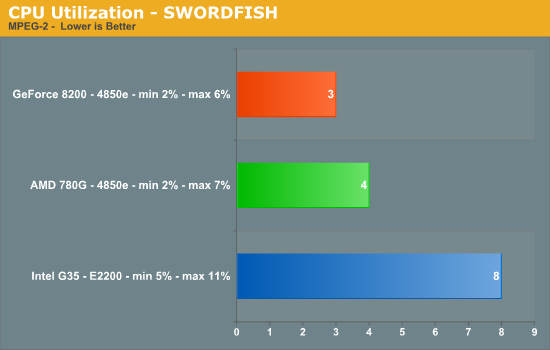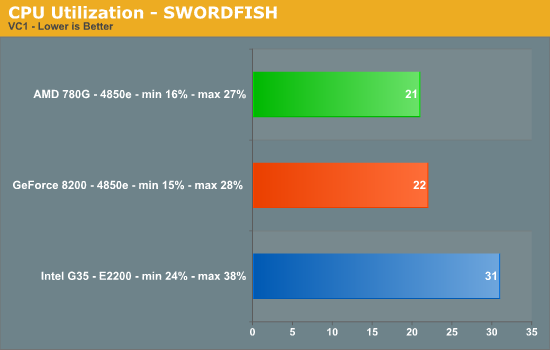AMD 780G: Preview of the Best Current IGP Solution
by Gary Key on March 10, 2008 12:00 PM EST- Posted in
- CPUs
Testing Notes
Our image quality tests today consists of still screenshots from several movies in our collection, actually the primary criteria were movies that offered decent bitrates and were screen capture friendly under DRM infested Vista. While we tried to capture the exact moment within a frame to compare the 780G to the G35/GF8200, this was not always possible. However, we did our best to capture the screenshots on the same frame but at times; the capture process grabbed the beginning of the frame or the trailing end.
In the end, we feel like the process is close enough to give you an indication to any differences between the images. Obviously, we cannot show the reference image but will comment as to which screen shot best represented the reference image on our home theater system. We find measuring video output quality in this manner a subjective process to some degree, as at times we liked an image that did not match the reference screenshot better than the one that did. Considering that fact, we decided to bring eight people in to give us their opinions during playback sequences and then still-shot reviews.
We utilized PowerDVD 7.3 (build 3610 utilized, 3730 in testing) for playback with all settings on auto, except we enabled hardware acceleration within the application. We measured CPU utilization and bitrate results with the Vista Task Manager and PowerDVD Info applications respectively. We took readings every five minutes and averaged the results at the end of the movie. Movies were played back in full screen mode at their native resolutions with the desktop set to 1920x1200. We will show discrete card results in our next article. However, the HD 3450 provided results that were just a few percent better than the HD 3200 with the released 8.3 driver set.
Audio settings selected were Dolby Digital 5.1, DTS 5.1, or two-channel LPCM where applicable. Unlike the 780G, the G35 and GeForce 8200 fully supports multi-channel LPCM output and we will comment on results with either LPCM 5.1 or Dolby TrueHD decoded streams (via PowerDVD) where applicable.
We calibrated both systems on our Gateway XHD3000 monitor to ensure the color palettes were set equally. Fine tuning the control panel settings for each of the test setups can and will improve the picture quality but we will leave that up to the user to decide their preferences. We played back the movie sequences on the Gateway monitor for initial viewing and judging. We proceeded to output the same movie sequences on our calibrated Samsung 61" (HL-T6187S) DLP set utilizing the same control panel and PowerDVD settings to view the images in an HT setting.
We then utilized our test setups to pass through the image and audio via HDMI to our Pioneer Elite VSX-94THX A/V receiver. Using the receiver as a "repeater", we output the native signal (our preferred method to PWDVD) to our HT setup (7.1 audio/Samsung 61” DLP) for our test subjects. We will list their preferences in our comments section. We will also warn you in advance that the original images are generally 2MB to 3MB in size if you decide to download them.
MPEG 2 Video Quality - SWORDFISH
We are utilizing the movie SWORDFISH from Warner Brothers, what else can we say, we still like seeing Halle Berry in the lounge chair. This movie offers bitrate levels that averaged 5.4 Mb/s to 8.1 Mb/s on average. In our particular test scene, John Travolta is drinking a cup of coffee in a close up shot that highlights skin tones along with reflections off the cup and background objects.
 780G – Click to Enlarge |
 G35 – Click to Enlarge
|
 GeForce 8200 – Click to Enlarge |
The differences in the images are minor but the G35 appears to have slightly deeper colors along with a slight edge in sharpness while the GeForce 8200 offers additional contrast and a better background image, but being darker overall. However, the 780G image was faithful to the reference image during playback tests. Our test audience placed 4 votes for the 780G, 2 for the G35, and 2 for the GeForce 8200.

CPU utilization during playback favors the 780G and GeForce 8200 on average by 4%. This was surprising to us as the G35 does not offer full hardware decode capabilities for MPEG-2 playback. However, we never had a problem with playback in this title and others such as Cars and Spiderman 3.
VC1 Video Quality - SWORDFISH
SWORDFISH is not a very demanding movie in 1080P playback but the image screenshots should give a good indication to the improvement when going from MPEG-2 to VC1. This movie offers bitrate levels that averaged 15.7 Mb/s to 25.2 Mb/s on average. Once again, we utilize the coffee shop test scene.
 780G – Click to Enlarge |
 G35 – Click to Enlarge |
 GeForce 8200 – Click to Enlarge |
The differences in the images are once again minor but this time the 780G appears to have better skin tones while sharpness and overall color palette seems to favor the G35. We thought the GeForce 8200 image was slightly on the flat side when comparing facial details but had the best background details. The 780G image was more faithful to the reference image during playback tests. The 780G garnered 3 votes, 3 to the G35, and 2 for the GeForce 8200.

CPU utilization during playback favors the GeForce 8200 and 780G by a several percent even though the G35 offers hardware accelerated decoding of the VC1 format. There were not any judder or stuttering problems on any of the platforms during playback.










49 Comments
View All Comments
derek85 - Tuesday, March 11, 2008 - link
You certainly don't know anything about multimedia.With a 780G + Phenom + 2ch DDR2-667 or 800 you are getting almost full HDHQV scores; with 8300GS the memory on those cards are severely limited to single channel DDR2-800 and you are not getting ANY HDHQV features, the image quality would be very poor in comparison, and there is no way to remedy that no matter how powerful your CPU is.
You said Phenom is not a good overclocker, and I agree with that, but what you got wrong is the market that 780G is aiming at. At this price point most people would never look at overclocking their PC, heck the average joe out there probably don't even know what's actually inside their computer case. The 780G will make a very good platform for everyday as well as a HTPC, and I'm sure it will be a good pick for OEMs.
derek85 - Tuesday, March 11, 2008 - link
Guess I hit enter button too soon...What I was trying to say is 780G excels in multimedia and will make its way into a damn good budget PC. You are looking at $50-60 saving in an entry level discrete graphics card, and probably $20-30 more on the motherboard at current running price for 780G. 780G will also do just fine in light gaming and usual productivity tasks. It can score 1600+ in 3DMark06, and a 8400GS is not going to do any better than that.
gochichi - Tuesday, March 11, 2008 - link
OK, so I'm excited for AMD. This kind of makes them really feasible again. I mean, for the price of a cheap video card... they throw in a free (and pretty decent) motherboard.I once read that some AMD official (maybe even the president, don't remember) thought that things are so tight in the CPU industry that it's a lot more profitable to make CPU cooling.
Well??? C'MON! There is currently no mainstream HTPC system. AMD could really sell these IF they could sell it even more as a platform. Why leave it up to so-far so-chintzy 3rd parties to make something decent.
What I would like to see is a "genuine" AMD thin case, with a power supply and a new type of AMD chip that comes with a flatter CPU cooler. All I want is space for one harddrive, and one 5.25" drive... make it as tight and slick as possible, and make it relatively affordable. Why not?
I mean, I know it won't happen. But it should. This promises tighter integration, and I believe that making this integration visible to the consumer via a slick AMD-branded case (work with Antec, Lian-Li or just AMD) that draws attention to the near console price that you can now build a system with.
Also, because Vista is so expensive to the people building their own machine. It is critical for them to offer splendid Linux support. If I knew it was plug & play with the next Ubuntu including audio through HDMI... that would sell it to me all over again.
AMD ALMOST has the price-point going on. Vista messes that up, expensive and UNIMPRESSIVE cases/power supplies messes that up as well.
Do you people realize that a Mac Min is currently the cheapest slick-form factor computer available??? How can that be? Apple is EXPENSIVE!?! It doesn't need to be ridiculously small... but slicker than the crap that's available.
Asus makes something like I have in mind but it's ran on Intel and is expensive as all get out.
AMD... give us the humble little platform that could. You're SO close now.
JarredWalton - Tuesday, March 11, 2008 - link
You know, I reviewed an Aopen MiniPC a long time ago. I burned out one fan in the process of a one month review. Okay, sure, I was stress-testing with Folding@Home, but that still gives me pause. Then I got a new fan, finished the review, and about two months later (without stress testing) the second fan gave out! I'd assume the Mac Mini is doing better than Aopen, since I haven't heard any uproar, but then I don't follow Macs much.More to the point, going *small* has some potential drawbacks. After initially being impressed by SFF and other small systems, I'm pretty much done with them now. uATX is more or less viable, but if you're looking for long-term reliability and don't want overheating and premature part failures, I would stick with a decent ATX case. The uATX stuff just never seems quite as robust after a couple years of use, IMO.
gochichi - Tuesday, March 11, 2008 - link
The Mac Mini wannabe that you're talking about was not what I had in mind. What I am saying is that buying a Mac Mini, and installing Windows Vista for $100.00 is still cheaper than most small/slick form factors.Now, Mac Mini is absurdly small (it's very well executed, and reliable as hell, but the slow harddrive etc is absurd IMHO). I'm suggesting something 8 times as big or so (2 mac minis tall, 4 per layer-ish). Just make it slick. It's REALLY not that hard!
I keep thinking I should just cast an aluminum case from scratch b/c the market is that lame. The few cases that aren't lame are over priced as hell. I suppose the really small HP is fine, (perfect even in terms of size/$/sacrifices). But what about the people that want to buy something from scratch and not undergo armed robbery and chintziness all at the same time.
AMD is unable to take things to the next level. This new vision of "lets not beat Intel in performance/$" COULD work, but it would need a gimmick. They are definitely missing that gimmick although this new chipset came close.
The only actual contribution to the world that this chipset has made is that Intel will beat it (or compete with it) and since Intel has stellar Linux support, better CPUs, and better battery life on laptops etc... that will be good. I really only need so much from a graphics card most of the time, and this 780G covers NEEDS.
phusg - Tuesday, March 11, 2008 - link
What's wrong with Shuttle SFF PC's? Sure the internal PSU crapped out on me after a few years, but I think mine looks pretty good.I do agree with your parent post though that SFF isn't really worth the hassle in a lot of cases. A HTPC is often accompanied by an AV Receiver and TV that are often both easily as big as ATX, so what's the point in going small for the PC component? I'm currently building a recylcled ATX machine as a HTPC to replace my Shuttle and am sure I will love the extra expansion slots, cooler temps and quieter operation. If AMD would just make a decent AGP driver release all will be good again...
JarredWalton - Tuesday, March 11, 2008 - link
What's wrong? I suppose it all depends on the TLC you give your computer. I'd *never* recommend overclocking Shuttle - or any other - SFFs. I did that in my early SFF reviews. Some of those systems I kept overclocked (and we're talking mild 10-20% overclocks), and most would fail within a year. Even *without* overclocking, nearly every SFF I've ever used failed in some manner before two years was up.Shuttle did better in this regard than others, but the long-term prospects are pretty poor. I had several motherboards fail (will no longer POST at all). I've had fan controllers fail on at least two units - still usable, but now you need to plug into a regular Molex connector and run the fan at 100%. PSUs have failed on maybe 1/3 of the SFFs I've used (within a two year period - most last at least a year).
The real issue with the above is that all SFFs are proprietary, so when something inevitably *does* fail, you get raped on price a second time. And taking the motherboard or PSU out of an SFF is not nearly as easy as in a uATX/ATX system. If you want the wiring to look nice again - which is actually critical in such a small chassis since it affects airflow - you're looking at many hours of work.
gochichi - Tuesday, March 11, 2008 - link
Building a computer on the cheap, doesn't add up anymore.AMD would be wise to partner up and make a conveniently priced, conveniently sized, platform. Because if the price is right and it's convenient then their performance deficit is not important.
sprockkets - Thursday, March 13, 2008 - link
They could always release a DTX board, like they said over a year ago.panfist - Tuesday, March 11, 2008 - link
Will it be worth waiting for a 790GX? Or if I want that much performance, just go with discrete graphics that's better than hybrid crossfire anyway?What's the best AMD HTPC board that uses discrete graphics?